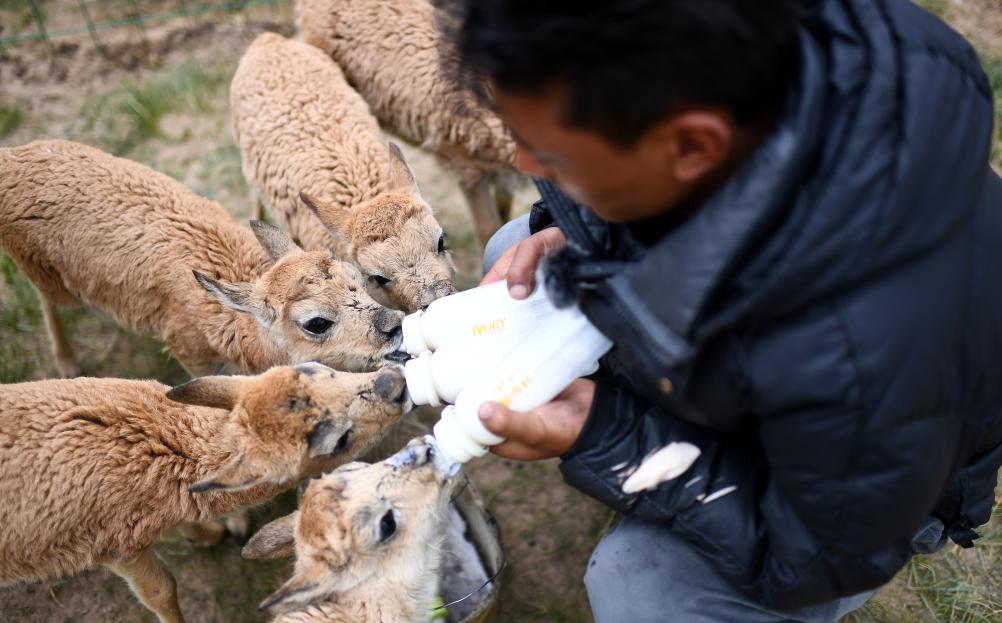 A staffer of the Hoh Xil management office feeds rescued Tibetan antelope calves in Hoh Xil, northwest China's Qinghai Province, July 28, 2023. (Xinhua/Zhang Hongxiang) Feb. 26, 2024 -- During the 2024 Chinese Lunar New Year, an important annual occasion marked by family get-togethers in China, Tsewen Dorje enjoyed a special time in the company of three Tibetan antelope calves.
For the past nine years, Tsewen Dorje, 31, has worked as a ranger at the Sonam Dargye Protection Station in northwest China's Hoh Xil, a nature reserve that encompasses China's largest stretch of uninhabited land within the Sanjiangyuan National Park. He was on duty during the Spring Festival holiday this month, and responsible for looking after the baby Tibetan antelopes at the protection station.
Zonag Lake, at the heart of Hoh Xil, is known as the "delivery room" for Tibetan antelopes, a species under first-class state protection in China. Every year, tens of thousands of pregnant Tibetan antelopes start their migration to Zonag Lake around May for birthing and then depart with their offspring in late July.
"During their migration journey, baby Tibetan antelopes are susceptible to getting separated from the herd due to adverse weather or attacks by predators," said Tsewen Dorje. "When we come across such 'stranded' calves, we bring them back to the protection station."
The three Tibetan antelope calves, which are six months old now, were found and rescued by Tsewen Dorje's patrol team during the migration season last year.
"They have been dependent on me. They are like my own children, and it is warm and soothing to be with them," said Tsewen Dorje. He also confirmed that the calves are in good health and will need to undergo wilderness training before meeting the criteria for release back into the wild.
To enhance protection efforts, a wildlife rescue center was set up at the station in 2002, securing it the reputation of being "the kindergarten of baby Tibetan antelopes." Covering an area of 550 mu (around 36.67 hectares), the rescue center has aided a total of over 600 wild animals of various types and helped more than 50 Tibetan antelope calves return to their natural habitat.
The establishment of the wildlife rescue center epitomizes the intensive efforts of China's government at all levels to protect Tibetan antelopes.
In recent years, authorities in Hoh Xil have constantly carried out mountain patrols and cracked down on anti-poaching activities to safeguard the reproduction and migration of Tibetan antelopes.
Improving the ecological environment is of vital importance for species protection. In this regard, the Sanjiangyuan area has initiated ecological migration programs, moving herders out of areas with fragile ecological environments, and limiting grazing on grasslands, to reduce the impact of human activities on the environment. Ecosystems including deserts and wetlands have been further protected and restored.
In addition, technological and legal support has also been provided. Since 2016, Qinghai Province, which administers Hoh Xil, has carried out the construction of a networked remote video observation system for real-time monitoring of key ecological areas, offering massive and detailed data support for biodiversity protection in the Sanjiangyuan region.
A national law concerning protection of the ecosystem of the Qinghai-Tibet Plateau was officially implemented in September 2023.
These efforts have borne fruit. The status of the Tibetan antelope in China has been downgraded from "endangered" to "near threatened." At present, Hoh Xil is home to more than 70,000 Tibetan antelopes, and the total combined population of Tibetan antelopes in the Xizang Autonomous Region, Qinghai Province and Xinjiang Uygur Autonomous Region has increased to around 300,000.
|
- Home
- News Tibet |Exclusive |China |World |Related News |Latest
- Documents White Papers |Others
- Photo Politics |Economy & Society |Culture & Religion |Human & Nature |Beautiful Tibet |Other Tibetan-Inhabited Area |Exchanges |Related
- Video News |Documentary |Micro-Video |Entertainment
- Art
- Tourism
- In Focus
- About Tibet






